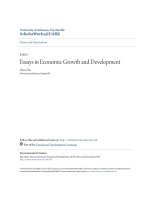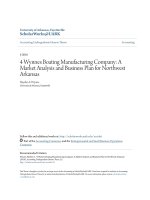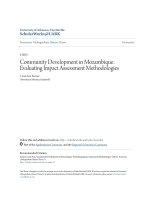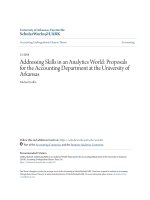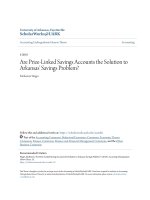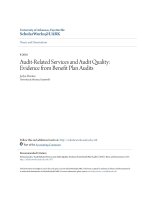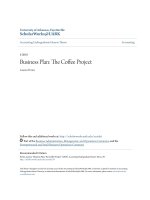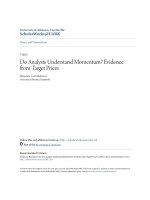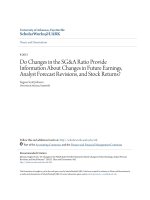Accounting undergraduate Honors theses: Does analyst experience affect their understanding of non financial information? An analysis of the relation between patent information and analyst
Bạn đang xem bản rút gọn của tài liệu. Xem và tải ngay bản đầy đủ của tài liệu tại đây (3.2 MB, 146 trang )
University of Arkansas, Fayetteville
ScholarWorks@UARK
Theses and Dissertations
8-2013
Does Analyst Experience Affect Their
Understanding of Non-Financial Information? An
Analysis of the Relation between Patent
Information and Analyst Forecast Errors
Taiwhun Taylor Joo
University of Arkansas, Fayetteville
Follow this and additional works at: />Part of the Accounting Commons, and the Finance and Financial Management Commons
Recommended Citation
Joo, Taiwhun Taylor, "Does Analyst Experience Affect Their Understanding of Non-Financial Information? An Analysis of the Relation
between Patent Information and Analyst Forecast Errors" (2013). Theses and Dissertations. 833.
/>
This Dissertation is brought to you for free and open access by ScholarWorks@UARK. It has been accepted for inclusion in Theses and Dissertations by
an authorized administrator of ScholarWorks@UARK. For more information, please contact ,
Does Analyst Experience Affect Their Understanding of Non-Financial Information?
An Analysis of the Relation between Patent Information and Analyst Forecast Errors
Does Analyst Experience Affect Their Understanding of Non-Financial Information?
An Analysis of the Relation between Patent Information and Analyst Forecast Errors
A dissertation submitted in partial fulfillment
of the requirements for the degree of
Doctor of Philosophy in Business Administration
By
Taiwhun T. Joo
Brigham Young University
Bachelor of Science in Accounting, 2009
Brigham Young University
Master of Accountancy, 2009
August 2013
University of Arkansas
This dissertation is approved for recommendations to the Graduate Council.
Dr. James Myers
Dissertation Director
Dr. Linda Myers
Committee Member
Dr. Junhee Han
Committee Member
Dr. Vernon Richardson
Committee Member
ABSTRACT
This study examines whether analyst experience affects the relation between patent
information and analyst forecast errors. U.S. Generally Accepted Accounting Principles require
that firms expense all in-house research and development (R&D) costs. This means that even
when R&D activities produce intangible assets with future economic benefits, firms cannot
capitalize R&D costs as assets. Consequently, financial statements are largely deficient in the
information they provide regarding the output of R&D activities. However, patent information is
one type of non-financial information about R&D output that is publicly available.
Using updated patent data, I confirm the results of prior studies that find a positive
association between patent citations and future firm performance. I also confirm the positive
association between the absolute value of analyst forecast errors and patent citations. Next, in my
main tests, I examine whether analyst experience affects the relation between patent information
and analyst forecast errors (absolute value and signed). I find that analysts with more experience
are not better at incorporating patent information to make more accurate earnings forecasts.
Instead, they incorporate patent information to make more optimistic earnings forecasts than
analysts with less experience. My findings should be of interest to standard setters in deciding
whether to require firms to disclose patent information because this information should be useful
to investors and analysts.
ACKNOWLEDGEMENTS
Special thanks are due to my dissertation committee members and other professors in the
Accounting Department for all of their comments and suggestions, as well as support. Also, a
special thanks goes out to my family and classmates in the Accounting Department for their
support, especially to Dr. E. Scott Johnson and Lauren Dreher for their friendship.
TABLE OF CONTENTS
1.
INTRODUCTION ...................................................................................................................1
2.
BACKGROUNDS AND HYPOTHESIS DEVELOPMENT .................................................4
2.1 Patents ................................................................................................................................4
2.2 R&D and Patent Information .............................................................................................5
2.3 Patent Information and Future Firm Performance .............................................................8
2.4 Patent Information, Forecast Revisions, and Forecast Errors ............................................9
2.5 Analyst Experience and the Relation between Patents Information and Forecast Errors..9
3.
SAMPLE SELECTION AND DATA ...................................................................................11
3.1 Sample Selection ..............................................................................................................11
3.2 Patent Measures ...............................................................................................................11
4.
METHODOOLGY ................................................................................................................13
4.1 Patent Information and Future Firm Performance ...........................................................13
4.2 Patent Information, Forecast Revisions, and Forecast Errors ..........................................15
4.3 Main Tests: Analyst Experience and the Relation between Patents Information and
Forecast Errors Patent Information, Forecast Revisions, and Forecast Errors .......................17
5.
RESULTS ..............................................................................................................................20
5.1 Descriptive Statistics ........................................................................................................20
5.2 Patent Information and Future Firm Performance ...........................................................20
5.3 Patent Information, Forecast Revisions, and Forecast Errors ..........................................21
5.4 Analyst Experience and the Relation between Patents Information and Forecast Errors22
6.
ADDITIONAL TESTS ..........................................................................................................23
6.1 Alternative Scaling for Patent Measures..........................................................................23
6.2 Other Types of Experience ..............................................................................................24
6.3 R&D Capital ....................................................................................................................27
6.4 Regulation Fair Disclosure ..............................................................................................28
6.5 Forecasting Horizons .......................................................................................................29
6.6 Industry Effects ................................................................................................................31
6.7 Truncating the Sample Period ..........................................................................................31
7.
CONCLUSION ......................................................................................................................32
8.
REFERENCES ......................................................................................................................35
9.
APPENDIX ............................................................................................................................39
10. TABLES ................................................................................................................................41
1. INTRODUCTION
This study examines whether analyst experience affects their ability to understand the
impact of patents on future earnings. Statement of Financial Accounting Standard (SFAS) No. 2,
Accounting for Research and Development Costs, requires firms to expense all in-house research
and development (R&D) costs as they are incurred. In other words, United States (U.S.)
Generally Accepted Accounting Principles (GAAP) treat investments in R&D as expenses, and
R&D costs are not capitalized on the balance sheets. This full expensing treatment of R&D
investments can weaken the link between current and future earnings. Therefore, analysts may
use non-financial information to supplement accounting information (Amir et al., 2003). Using a
sample of firms with patents granted from 1994 through 2005, this study examines the relation
between patent information and analyst forecast errors, and investigates whether analyst
experience affects this relation.
Some patents are more economically valuable than others. Trajtenberg (1990) finds that
the number of citations that a firm’s patents receive from follow-up patents is a better proxy for
R&D output than is the number of patents. Patent citations arise when follow-up patents cite
previous patents.1 Prior studies find that firm value is positively associated with patent citations
(Hirschey et al., 2001; Hall et al., 2005). Other studies find a positive relation between patent
citations and future firm performance (Gu, 2005; Pandit et al., 2011). Before I examine the effect
of analyst experience on the relation between patent information and forecast errors, I confirm
that the findings of these prior studies exist for my sample. Using updated patent data, I find that
the number of patent citations is positively associated with future earnings.2 After confirming
1
2
This is similar to academic studies citing previous studies.
The methodology section provides more detailed descriptions of my patent measures and tests.
1
that firms with more patent citations have better future performance, I also confirm that analysts,
on average, make less accurate earnings forecasts for firms with more patent citations.
The inherent difficulty in estimating the value of intangible assets is the main reason that
U.S. GAAP requires firms to expense the full costs of in-house R&D as incurred (FASB, 1974).
Furthermore, active and transparent markets for intangible assets are limited (Gu and Wang,
2005). This lack of information about the value of R&D output might encourage financial
analysts to use information not disclosed in financial reports, such as patent data available
through the United States Patents and Trademarks Office (USPTO), when forecasting future
earnings. However, even though patent information from USPTO is publicly available, analysts
may be unable to fully understand the implications of patents for future earnings due to the
uncertainty associated with new technologies (Aboody and Lev, 1998; Amir et al., 2003).
Consistent with this, Amir et al. (2003) find that analyst forecasts are less accurate and more
optimistic in industries that are more R&D intensive. Using the model from Amir et al. (2003), I
confirm that the analyst consensus earnings forecast is less accurate for firms with more patent
citations. I do not find evidence, however, that patent citations are related to forecast optimism.
This leads to my main research question. Do analysts learn from their experience in using
patent information to make more accurate earnings forecasts? Prior studies find that, on average,
more experienced analysts make more accurate earnings forecasts (Mikhail et al., 1997; Clement,
1999). In addition, Drake and Myers (2011) find that analysts’ general experience is associated
with less accrual-related over-optimism, even when controlling for analysts’ firm-specific
experience. They measure general experience as the number of prior years in which an analyst
makes earnings forecasts for any firm, and firm-specific experience is the number of prior years
in which an analyst makes earnings forecasts for a given firm.
2
In this study, I focus on firm-specific experience because patents are unique across
firms.3 If patent information is difficult to incorporate into forecasts, even with experience, I
expect analyst experience to have no effect on the relation between patent information and
forecast errors. If analysts with more experience have a better understanding of the implications
of patents for future earnings, I expect analysts with more experience to make more accurate
earnings forecasts. I find, however, that analysts with more experience are not better at using
patent information to make more accurate earnings forecasts. Interestingly, analysts with more
experience appear to use patent information to make more optimistic earnings forecasts. Overall,
I conclude that analysts with more experience have some understanding of the benefits of patents,
but this understanding does not lead to more accurate earnings forecasts.
My study contributes to the existing R&D literature. My finding suggests that analysts
with more experience have some understanding of patent information. However, this
understanding is limited in that it allows more experienced analysts to make more optimistic, but
not more accurate, earnings forecasts. Regulators may consider requiring firms to disclose more
information about the output of R&D activities because this information about R&D outputs
appears to be useful and no other publicly available information on the output of R&D activities
is widely available. Other voluntary disclosures on the benefits of R&D output, such as patent
licensing income, is rare even among large firms investing heavily in R&D (Gu et al., 2004).
Perhaps because of this lack of information, Cohen et al. (2013) find that the market does not
value past R&D activities appropriately.
My study also contributes to the analyst forecast literature by showing that financial
analysts do not fully incorporate all of the available information about patents when making
3
In additional analyses, I explore the impact of general experience, industry-specific experience,
and task-specific experience on analysts’ understanding of the information in patent citations.
3
earnings forecasts. Bradshaw, Richardson, and Sloan (2001) find that analysts are overoptimistic in valuing accruals. Given that prior studies observe a positive relation between patent
information and future firm performance, one would expect analyst forecasts to incorporate
patent information to compensate for the lack of other R&D output information. However, I
confirm that patent citations are associated with less accurate earnings forecasts. Furthermore, I
find that analysts with more experience are not better at making more accurate earnings forecasts
by incorporating patent information, although they do seem to better understand that patents lead
to improved future performance.
The remainder of this paper is organized as follows. Section 2 discusses previous
research and presents my hypotheses. Section 3 describes the data, and Section 4 explains my
methodology. Section 5 presents the results from my analyses, and Section 6 presents results of
additional tests. Section 7 concludes.
2. BACKGROUND AND HYPOTHESIS DEVELOPMENT
2.1. Patents
A patent is intellectual property that gives an inventor the right to “exclude others from
making, using, offering for sale, or selling the invention throughout the United States or
importing the invention into the United States” for a specified time.4,5 Intellectual property rights
are critical to the modern economy. The Copyright and Patent Clause of the United States
Constitution allows the United States Congress to exercise enumerated power “to promote the
Progress of Science and useful Arts, by securing for limited Times to Authors and Inventors the
4
See 35 U.S.C. 154 (a)(1) (2006).
Other common types of intellectual property include copyrights, trademarks, and industrial
design rights.
5
4
exclusive Right to their respective Writings and Discoveries” (U.S. Constitution, Article I,
Section 8). Not only are individuals guaranteed property rights for tangible assets, but also for
intangible assets (i.e., the individuals’ ideas). This right for inventions gives individuals and
firms incentives to invest time and effort in innovative discoveries. In exchange, the inventor
discloses information about the invention to the public. The USPTO assigns patents to individual
inventors or to the firms for whom the inventors work. Thus, the patent rights encourage firms to
invest in innovative technologies by promising these firms exclusive rights to use the patents,
given that the legal system is able to enforce these rights. Lieberman and Montgomery (1988)
highlight success in patents as a mechanism by which a firm establishes technology leadership,
which leads to a first-mover advantage. However, there is currently no requirement for firms to
disclose information about patents or R&D activities in their financial statements.
2.2 R&D and Patent Information
The prevalence of private R&D activities makes this study relevant. In the past half
century, while the investment in R&D activities as a proportion of the U.S. Gross Domestic
Product has remained steadily at 2-3%, the proportion of private R&D has increased and
government-sponsored R&D has decreased (Cohen et al. 2013). Cohen et al. (2013) suggest that
the responsibility for allocating resources in R&D is on the private sector rather than on the
government. Therefore, the ability of market participants to understand the benefits of R&D
activities and to allocate resources accordingly is important.
The motivation for my study starts with patent information and its association with future
firm performance. Consider a firm that incurs costs to conduct in-house R&D activities. These
5
activities produce intangible assets that have some economic value.6 This paper refers to these
intangible assets as “R&D capital.” Currently, U.S. GAAP does not allow firms to capitalize any
in-house R&D costs (SFAS No. 2); therefore, even if a firm were successful in R&D, the
financial statements would not reflect any R&D capital on their balance sheet. Instead, the full
amount of R&D costs incurred during the year would show up on the firm’s income statement as
R&D expense.
If U.S. GAAP allowed firms to capitalize R&D costs, there would be significant
subjectivity in determining how much of R&D costs should be capitalized. This subjectivity and
uncertainty about the future implications of R&D capital are the main reasons why the Financial
Accounting Standards Board (FASB) requires full expensing treatment. Thus, financial
statements contain only information about the input of R&D activities (in the form of R&D
expense), and lack information about the value of the output from R&D activities. Rong (2012)
suggests that market participants lack access to a considerable amount of information about
R&D activities because management chooses to not disclose this information. Currently, there is
no requirement for firms to disclose the estimated value of R&D capital, and there is no active
market for many of these intangible assets. Perhaps because of this lack of information, Cohen et
al. (2013) find that the market generally misvalues R&D investment. However, sophisticated
market participants, such as analysts, may compensate for this lack of information about the
value of R&D capital with non-financial information (Amir et al., 2003). One type of nonfinancial information analysts can use is patent information because patents are the output of
R&D activities and are publicly available from the USPTO.
6
The value of R&D capital, as with other assets, would be the present value of future earnings
generated by the asset.
6
Patent information may be informative to market participants in a number of ways. First,
if a person can understand the potential impact of a patented technology, patent information may
shed light on future sales of a product or on the reduced cost of manufacturing a product. Other
information patents contain is the potential for royalty income. Second, market participants may
use patent information to estimate potential royalty income. Gu et al. (2004) find that royalty
income is more persistent than earnings. However, the authors state that voluntary disclosures
about royalty income from patent licensing are uncommon. Lastly, Cohen et al. (2013) suggest
that past information about R&D successes is informative about potential future success of R&D.
They find that stock returns of firms with higher ratios of R&D expense to sales in the past
perform better in the future than do firms with the same dollar amount of R&D expense, but
lower ratios of R&D expense to sales.
My patent measures count the number of citations that firms’ patents subsequently
receive. More important patents are likely to be cited more often, while less important or obscure
patents are likely to receive fewer citations.7 Empirical studies find that the number of citations
patents receive is a proxy for the patent’s importance or innovativeness (Trajtenberg, 1990;
Harhoff et al., 1999; Hall et al., 2005). Trajtenberg (1990) follow prices and subsequent patent
citations for Computed Tomography (CT) scanners to examine the value of innovations. He finds
that patents for CT scanners that command higher prices, receive more subsequent citations than
patents for CT scanners that command lower prices. Harhoff et al. (1999) survey German firms
with patents. The authors ask the firms to value the firms’ patents and follow the subsequent
citations for those patents. They find that the number of patent citations is positively associated
with the value of patents assigned by the firms. Rong (2012) also suggests that the number of
7
This is analogous to more important academic studies receiving more citations than less
important studies.
7
patent citations is a signal of economic importance. I use patent citations as information about
the firms’ R&D success.
2.3 Patent Information and Future Firm Performance
Before examining whether analysts’ experience improves their understanding of patent
information in making earnings forecasts, I test whether the number of patent citations is useful
for predicting future earnings. This answers the question of whether a parsimonious count of
patent information contains information related to the success of R&D activities and future firm
performance. In prior research, Hirschey et al. (2001) and Hall et al. (2005) find a significant and
positive association between patent citations and Tobin’s q, and Gu (2005) and Pandit et al.
(2011) find that patent citations are positively associated with future earnings.
I construct three patent citation measures to proxy for information about the output of
R&D activities. The first measure is the total number of citations received in the current year.
The number of patent citations in the current year is a proxy for the economic importance of a
firm’s patents or a signal of potential royalty income from patent licensing. The second measure
counts patent citations over the past five years. This measure is a proxy for the information about
a firm’s patent portfolio. The third measure is the number of citations received in the past years,
in the current year, and in the future years. Although the number of citations a patent receives in
the future is not observable ex ante, if analysts understand the future implications of specific
patents, this measure may be a good measure of the overall economic importance of patents. I
use future earnings to measure future performance and confirm that prior findings – that patent
citations are positively associated with future firm performance – exist in my sample. Additional
tests using return on assets (ROA) as a measure of firm performance also confirm these findings.
8
2.4 Patent Information, Forecast Revisions, and Forecast Errors
Next, I test whether patent information is associated with analyst forecast revisions and
forecast errors (both absolute value and signed). Patent information may provide analysts with
additional information about R&D capital. If this is the case, I expect patent information to be
associated with analyst forecast revisions. I also expect patent information to be associated with
more accurate earnings forecasts. Finally, I expect patent information to be associated with more
optimistic earnings forecasts, given the positive relation between patent information and future
firm performance. Alternatively, if patent information is difficult to understand and does not
provide analysts with additional information about R&D capital, I expect to find no association
between patent information and forecast revisions. I also expect patent information to be
associated with less accurate earnings forecasts, and do not expect any difference in signed
forecast errors.
A few prior studies examine the relation between patent information and analyst forecast
errors. Using a sample of observations from 1983 through 1999, Gu (2005) finds that analysts,
on average, underestimate the future implications of patent citations. In a follow-up study, Gu
and Wang (2005) find that more innovative patents are associated with less accurate earnings
forecasts.8
2.5 Analyst Experience and the Relation between Patent Information and Forecast Errors
This leads to my main research question. How does an individual analyst’s experience
affect the relation between patent information and analyst forecast errors? Learning-by-doing
theory predicts that people learn to perform tasks better as they gain more experience related to
the tasks (Arrow, 1962; Anzai and Simon, 1979). Arrow (1962) models how experience
8
The authors use patent citations as a proxy for the innovativeness of patents.
9
increases labor productivity over time and Anzai and Simon (1979) study how people learn to
perform a task during a problem-solving process. Test subjects in Anzai and Simon’s experiment
are given the task of solving the Tower of Hanoi puzzle. The authors document how their
subjects learn by producing strategies and adapting.
In the accounting literature, an experimental study by Shelton (1999) finds that more
experienced auditors (both audit managers and partners) place less weight on irrelevant
information than do less experienced auditors (i.e., audit seniors). In addition, prior studies find
that more experienced analysts make more accurate earnings forecasts (Mikhail et al., 1997,
2003; Clement, 1999). In my study, on the one hand, more experienced analysts may be able to
better understand the future implications and benefits of patents. On the other hand, the
implications and benefits of R&D capital are inherently difficult to estimate, which is why the
FASB does not allow firms to capitalize in-house R&D costs in the first place. Thus, an analyst’s
experience may not allow him to overcome the inherent difficulty in estimating the future
implications and benefits of patents. In this study, I focus on firm-specific experience because of
the uniqueness of each firm’s patents. My first hypothesis, stated in the alternative form, is:
H1: More experienced analysts are better at incorporating patent information to make
more accurate earnings forecasts.
My second hypothesis relates to how analyst experience affects signed forecast errors.
Given that patent information is positively related to future performance, I expect analysts who
understand this relation to make more optimistic earnings forecasts than those who do not.
Furthermore, analysts may learn to better understand this relation with experience. On the one
hand, if more experienced analysts better understand the positive relation between patent
information and future earnings, I expect their earnings forecasts to be more optimistic than
10
earnings forecasts of less experienced analysts. On the other hand, if more experienced analysts
do not understand the positive relation between patent information and future earnings any better
than less experienced analysts, I do not expect their earnings forecasts to be more optimistic.
H2: More experienced analysts are better at incorporating patent information to make
more optimistic earnings forecasts than less experienced analysts.
3. SAMPLE SELECTION AND DATA
3.1 Sample Selection
I examine earnings forecasts from 1994 to 2005. Beginning in 1994 ensures that the
analyst earnings forecast data are consistent throughout the sample period because I/B/E/S
changed its method of calculating actual earnings per share (EPS) in the early 1990s (Abarbanell
and Lehavy, 2007; Drake and Myers, 2011). I exclude from my sample industries and firms that
do not have any patent. After eliminating observations with insufficient data from the Compustat
Annual file, stock return data from the CRSP Monthly file, and analyst data from the I/B/E/S
Detailed file between 1994 and 2005, my sample consists of 36,278 analyst-firm-year
observations. This sample includes 4,364 unique analysts, 1,576 unique firms, and 206 unique
industries (3-digit SIC code).
3.2 Patent Measures
I construct my patent measures using publicly available data from the National Bureau of
Economic Research (NBER) Patent Data Project Web site. Specifically, I use the following
datasets: [1] the dataset of records for every patent (more than 3.2 million observations from
1976 through 2006), [2] the dataset that matches patents to assignee codes, [3] the dataset that
matches assignee codes to firm codes (GVKEY in Compustat), and [4] the dataset that matches
11
cited patents to citing patents. I merge the four datasets into observations with firm identifiers,
fiscal years, cited patent identifiers, and citing patent identifiers. I then construct three measures
of patent information:
1. Number of new patent citations in the current year;
2. Number of patent citations in the past five years;
3. Number of total citations (over a five-year rolling period and in the future) related to
patents granted in the past five years.
In prior studies, to control for the number of citations patents usually receive in a given field, the
number of citations is generally scaled by the average number of citations received in the
industry (Hirschey et al., 2001) or in the technology classification (Gu, 2005; Pandit et al., 2011).
I scale each measure by the median value for the 3-digit SIC code industry and year.9, 10 This
scaling adjusts the patent measures to reflect the number of patent citations compared to other
firms in the same industry in the same year (Hirschey et al., 2001).
The first measure counts the number of citations a firm’s patents receive in a given year.
Trajtenberg (1990) finds that the number of citations received is better for R&D output than the
9
I calculate industry-year medians only with firms that have at least one patent or citation during
that particular year. Using the industry-year mean does not change my results.
10
Scaling by the industry benchmark is consistent with Hirschey et al. (2001). Other prior
studies (Gu, 2005; Pandit et al., 2011) adjust their measures by means of each USPTO
subcategory year. Using these means does not change my results. I use industry-year instead of
subcategory-year for two reasons: (1) Table 1 of Gu (2005) shows an example of Patents with
their IDs and Patent Subcategories. I find discrepancies between the Patent Subcategories
presented and the USPTO Classification from the actual patent documents. Rather, the Patent
Subcategory numbers seem to come from the manner in which the NBER categorized the patent,
not the USPTO. (2) Patents can be listed under multiple subcategories. An example illustrates
both of these reasonings: Table 1 Panel A (Gu, 2005) shows a patent ID of 4911173 with a
Patent Subcategory of 32. The original patent document (available on the USPTO via Google
Patent) shows that the correct U.S. Classification is 128/662.06 and 128/4. The subcategory
number 32 is given by the researchers who compiled the data available on NBER, not the
USPTO.
12
number of a firm’s patents. In other studies, the number of citations captures the relative
importance of patents a firm holds (Gu, 2005; Gu and Wang, 2005; Pandit et al., 2011). The
reasoning is that more important or innovative patents receive more citations from follow-up
patents than less important or obscure patents. The second patent measure is the sum of the
number of all citations received in the past five years. I use this measure that includes citations
received in the previous years as well as the current year because the information about previous
R&D success may be relevant this year (Cohen et al., 2013), The third measure is the number of
citations in the past five years and in the future related to the past five years’ patents. The
reasoning for using patents granted in the past five years follows the finding in Lev and
Sougiannis (1996) that R&D capital (the sum of R&D expenses assuming straight-line
depreciation) is value relevant, on average, for five years. I use these three patent citation
measures as information about the firms’ patents whether this information is a signal of
economic importance for future royalty income or for future R&D success.
4. METHODOLOGY
4.1 Patent Information and Future Firm Performance
Before examining how analyst experience affects the relation between patent information
and forecast errors, I confirm the association between patent citations and future firm
performance found by prior studies (Gu, 2005; Pandit et al., 2011). If patents guarantee firms
exclusive rights to discoveries and inventions, I expect firms with more patents to have better
future firm performance. I follow the future earnings model in Cao et al. (2011) and estimate all
regressions in this study using ordinary least squares. I control for heteroscedasticity using
Roger’s standard errors and by clustering the residuals by firm (Petersen, 2009):
13
Ei,t+1 = α0 + α1 PATENTi,t +α2 Ei,t + α3 (D1 * Ei,t) + α4 ΔEi,t + α5 (D2 * ΔEi,t)
+ α6 ΔBVi,t-1 + α7 (D3 * ΔBVi,t-1) + α8 ΔDi,t + α9 BMi,t + α10 ΔRDCAPi,t
+ α10 RD_EXPi,t + εi,t
[1]
where
Ei,t+1
= operating income after depreciation for firm i in t+1 scaled by the
market value of equity at the end of year t;
PATENT
= one of the following six patent measures:
1. Number of new patent citations in the current year,
2. Number of patent citations in the past five years,
3. Number of total citations (over a five-year rolling period and in the
future) related to patents granted in the past five years;
Ei,t
= operating income after depreciation for firm i in t scaled by market value
of equity at the end of year t;
D1
= an indicator set to 1 if Ei,t is negative, otherwise 0;
ΔEi,t
= change in operating income after depreciation for firm i from t-1 to t
scaled by market value of equity at the end of year t;
D2
= an indicator set to 1 if ΔEi,t is negative, otherwise 0;
ΔBVi,t-1
= the change in book value of equity for firm i from year t-2 to year t-1
scaled by market value of equity at the end of year t-1;
D3
= an indicator set to 1 if ΔBVi,t-1 is negative, otherwise 0;
ΔDi,t
= change in dividends for firm i from year t-1 to year t scaled by market
value of equity at the end of year t-1;
BMi,t
= book value of equity divided by market value of equity for firm i in
year t;
ΔRDCAPi,t
= change in R&D capital. R&D capital is calculated as (R&D expense in
year t * 0.9 + R&D expense in year t-1 * 0.7 + R&D expense in year t-2 *
0.5 + R&D expense in year t-3 * 0.3 + R&D expense in year t-4 * 0.1)
scaled by market value of equity at the end of year t-1;
RD_EXPi,t
= R&D expense in year t.
14
I also use an alternative measure of future firm performance. ROAi,t+1 is defined as
operating income after depreciation for firm i in t+1 scaled by total assets at the end of year t:
ROAi,t+1 = α0 + α1 PATENTi,t +α2 Ei,t + α3 (D1 * Ei,t) + α4 ΔEi,t + α5 (D2 * ΔEi,t)
+ α6 ΔBVi,t-1 + α7 (D3 * ΔBVi,t-1) + α8 ΔDi,t + α9 BMi,t + α10 ΔRDCAPi,t
+ α10 RD_EXPi,t + εi,t
[2]
I also examine the earnings and ROAs for year t+2 because the benefits of patents may take
more than a year to manifest.
Lastly, I use gross margin percentage as the dependent variable. If patents grant exclusive
rights to the firms holding them, the firms may be able to command higher prices for their
products or reduce costs of productions through patented technologies. Thus, I use gross margin
percentage as the dependent variable for an exploratory reason:
GM%i,t+1 = α0 + α1 PATENTi,t +α2 Ei,t + α3 (D1 * Ei,t) + α4 ΔEi,t + α5 (D2 * ΔEi,t)
+ α6 ΔBVi,t-1 + α7 (D3 * ΔBVi,t-1) + α8 ΔDi,t + α9 BMi,t + α10 ΔRDCAPi,t
+ α10 RD_EXPi,t + εi,t
[3]
where
GM%i,t+1
= sales minus cost of goods sold divided by sales for firm i in t+1;
All other variables are as defined above.
In order to maximize the number of observations, I extend the sample period back to 1988
because these tests do not include analyst characteristics variables.
4.2 Patent Information, Forecast Revisions, and Forecast Errors
Next, I test whether patent information is associated with analyst forecast revisions and
forecast errors. For analyst forecast revisions, I follow Cao et al. (2011):
FR i,t+1= α0 + α1 PATENTi,t +α2 Ei,t + α3 (D1 * Ei,t) + α4 ΔEi,t + α5 (D2 * ΔEi,t)
+ α6 ΔBVi,t-1 + α7 (D3 * ΔBVi,t-1) + α8 ΔDi,t + α9 BMi,t + α10 ΔRDCAPi,t
+ α10 RD_EXPi,t + εi,t
[4]
15
where
FRi,t+1 = the earnings forecast revision measure calculated as earnings forecast for t+1
for firm i following the announcement of year t earnings minus the earnings
forecast for t+1 for firm i following the announcement of year t-1 earnings scaled
by the absolute value of the latter;
All other variables are as defined above.
I expect the coefficient on PATENT to be statistically significant if patent information is
informative to analysts in forecasting and revising future earnings estimates. A positive (negative)
and significant coefficient means analysts revise their earnings forecasts optimistically
(pessimistically) with patent information. A statistically insignificant coefficient means that
analysts do not find patent information to be informative or relevant in revising their forecasts.
Next, I use the model from Amir et al. (2003) to test for an association between patent
information and analyst forecast errors. Following Amir et al. (2003), I use the absolute value of
forecast errors (forecast accuracy) and signed forecast errors as my dependent variables. Larger
absolute values of forecast errors represent less accurate forecasts, while small absolute values
represent more accurate forecasts. More negative signed forecast errors represent more optimistic
earnings forecasts, while more positive signed forecast errors represent more pessimistic
earnings forecasts.
Abs(FEi,t+1)
= α0 + α1 PATENTi,t + α2 R&DIntensityi,t + α3 SIZEi,t + α4 CVERi,t
+ α5 ln(AGE i,t )+ εi,t
[5]
FE i,t+1
= α0 + α1 PATENTi,t + α2 R&DIntensityi,t + α3 SIZEi,t + α4 CVERi,t
+ α5 ln(AGE i,t )+ εi,t
[6]
where
Abs(FE i,t+1)
= forecast accuracy calculated as the actual t+1 earnings minus the
earnings forecast for year t+1 earnings most immediately after the year t
16
earnings announcement scaled by the stock price at the year t fiscal year
end;
FE i,t+1
= signed forecast errors calculated as the actual t+1 earnings minus the
earnings forecast for year t+1 earnings most immediately after the year t
earnings announcement scaled by the stock price at the year t fiscal year
end;
RDIntensityi,t = the R&D intensity calculated as R&D capital divided by the sum of
book value of equity and R&D capital. R&D capital is calculated as (R&D
expense in year t * 0.9 + R&D expense in year t-1 * 0.7 + R&D expense
in year t-2 * 0.5 + R&D expense in year t-3 *0.3 + R&D expense in year t4 * 0.1);
SIZEi,t
= the natural log of market value of equity;
CVERi,t
= the coefficient of variation for earnings calculated as the standard error
of the past five annual earnings divided by the absolute value of mean
earnings;
Ln(AGEi,t)
= firm age calculated as the natural log of the number of continuous year
observations on Compustat.
If analysts misunderstand (understand) the positive future firm performance implications
of patent information, I expect the coefficient on PATENT to be positive (negative) and
significant for Equation [5]. For Equation [6], I expect the coefficient on PATENT to be negative
(positive) and significant if analysts are optimistic (pessimistic) about patent information.
4.3 Main Tests: Analyst Experience and the Relation between Patents and Forecast Errors
To test my main hypotheses, I follow the Drake and Myers (2011) model. I rank all
continuous independent variables into deciles and standardize them to be between 0 and 1
(denoted by a superscript R), consistent with prior studies (Bradshaw et al., 2001; Collins et al.,
2003; Drake and Myers, 2011). I start with the forecast error variables as dependent variables.
My independent variables are patent measure, analyst firm-specific experience and the
interaction term between the two variables:
17
Abs(FE i,j,t+1) or FE i,j,t+1 = α0 + α1 RPatenti,t + α2RPatenti,j,t * α3RFexpi,j,t + α3 RFexpi,j,t
+εi,j,t
[7]
where
Abs(FE i,j,t+1) = absolute value of the actual t+1 earnings minus the earnings forecast for
year t+1 earnings most immediately after the year t earnings
announcement for firm i and analyst j scaled by the stock price at the year
t fiscal year end;
FE i,j,t+1
= actual t+1 earnings minus the earnings forecast for year t+1 earnings
most immediately after the year t earnings announcement for firm i and
analyst j scaled by the stock price at the year t fiscal year end;
Patenti,t
= One of six patent measures as defined previously;
Fexpi,j,t
= number of years analyst j has issued earnings forecasts for firm i in
I/B/E/S.
Next, I add control variables for financial information:
Abs(FE i,j,t+1) or FE i,j,t+1
= α0 + α1 RPatenti,t + α2RPatenti,t * α3RFexpi,j,t + α3 RFexpi,j,t
+ α4 RWCaccri,t + α5 RWCcfoi,t + α6R Abs(FE i,j,t) or FE i,j,t
+ α7 Lossi,t + α8 EquityOffi,t + α9 RBTMi,t + α10 RRecomi,t
+ α11 RReti,t + α12 RNumest + α13 RSizei,t + α14 RAgei,t + ε i,t
[8]
where
WCaccri,t
= working capital accruals calculated as Increase in A/R + Increase in
Inventory + Decrease in A/P and Accrued Liabilities + Decrease in
Accrued Income Taxes + Increase (Decrease) in Other Assets (Liabilities),
scaled by average assets;
WCcfo i,t
= working capital cash flow calculated as Earnings before Interest, Taxes,
Depreciation, and Amortization minus working capital accruals, scaled by
average total assets;
Abs(FE i,j,t) or FE i,j,t = the lag of either Abs(FE i,j,t+1) or FE i,j,t+1;
Lossi,t
= 1 if Income before Extraordinary Items is less than 0, otherwise 0;
EquityOffi,t
= equity offering indicator set to 1 if sales of common and preferred stock
are greater than purchases of common and preferred stock by more than 5%
of total assets, otherwise 0;
18
